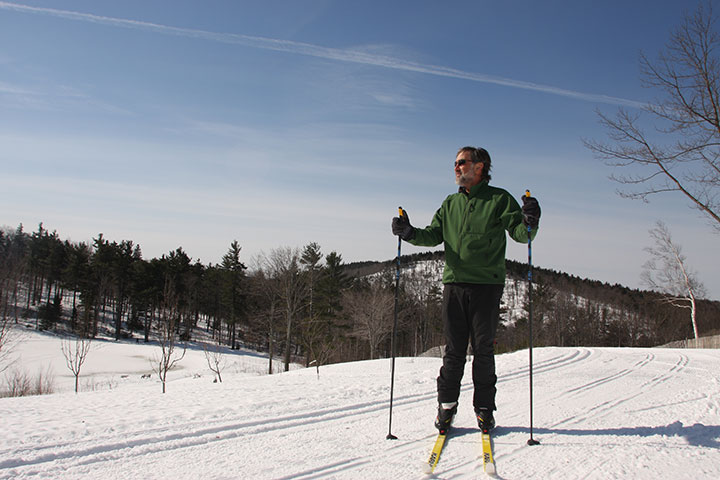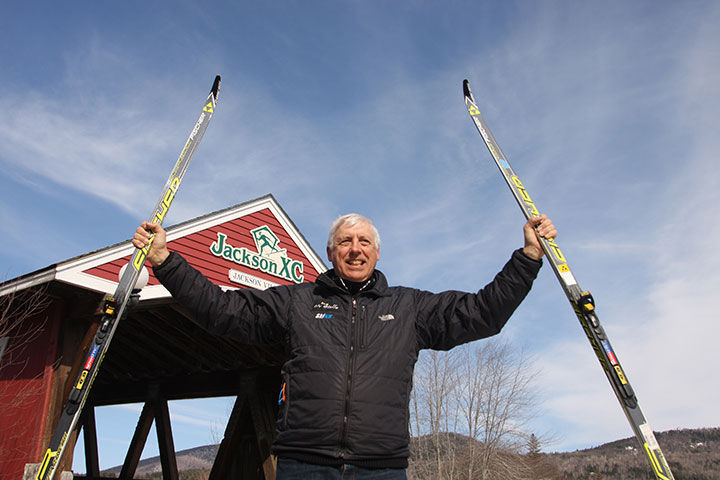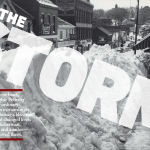Trailblazers | Nordic Skiing
New Hampshire’s thriving Nordic ski scene owes a debt to the visionaries who saw the future and worked to make it happen. It takes courage—and a good dose of blind optimism—to see the hilly, rock-filled forests of New Hampshire as the landscape for a thriving winter pastime. But in the mid-1970s, that was exactly what […]

Coffee By Design | Portland, Maine
Photo Credit : Katherine KeenanNew Hampshire’s thriving Nordic ski scene owes a debt to the visionaries who saw the future and worked to make it happen.

Photo Credit : Annie Card
It takes courage—and a good dose of blind optimism—to see the hilly, rock-filled forests of New Hampshire as the landscape for a thriving winter pastime. But in the mid-1970s, that was exactly what Al Jenks, Thom Perkins, John Schlosser, and Steve Flagg imagined. Equipped with little more than a few homemade implements, beater snowmobiles, and a lot of pluck and ingenuity, they persisted in creating a culture of cross-country skiing in the Granite State.
There were people interested in the sport for generations before these intrepid pioneers. But who would dare to charge visitors for the experience of skiing quality cross-country trails, even if they were groomed? It had never been done in the heartland of Yankee frugality. Anyone who wanted to ski could just walk into the woods and fields and tramp around for free.

Photo Credit : Annie Card
That was just one of the many challenges that cross-country operators faced. There was no history of past success in selling the sport in the United States, and no proof that cross-country skiing would prosper in the future. Those who dared to test the waters began without a blueprint. Consider the experience of Thom Perkins, who, when he accepted his job at the Jackson Ski Touring Foundation (Jackson XC) in 1976, walked into a four-year-old organization ridden with debt and a few overgrown trails. He inherited one groomer, two staffers, and a 12-by-12- foot room from which to run his operations. Perkins believed from the start that “better days lay ahead.” For the next few years, he supported his family of four on $5,000 a year.
With few funds, Perkins and his team worked with what they had. They cleared woods trails with a borrowed chainsaw. All ticketing, lodging assistance, rescue operations, and promotional business came from that tiny room. “We’d make 100 calls a day with updates on ski conditions,” Perkins recalls. “We called all the local lodging establishments, restaurants, chambers of commerce, ski shops—including L.L. Bean in Freeport, Bob’s Wilderness House in Boston, REI, and EMS—and several radio stations and newspapers in the New England area.” Decades later, Jackson is now famous as the Nordic center of the East, with 150 kilometers of trails. Today Perkins works as a consultant for Nordic centers throughout the country, but he can still rattle off those phone numbers by heart.
Despite (and maybe because of) the daunting demands of the job, cross-country ski operators viewed one another as comrades, meeting regularly for shoptalk and support. “Everyone was in their mid-twenties to early thirties, and we were all trying to make a business out of nothing,” remarks John Schlosser, operator of New London’s Norsk Cross Country Ski Center (now closed) for more than 25 years and current owner of Pine Hill Ski Club. Perkins remembers his nights sleeping on the floors of many friends’ houses as they struggled to write the first Nordic instructor manual. There were conferences and ski demos as the network of Nordic operators spread throughout the United States.
Still, there was time for fun. “There was more of a ‘get outside and play’ kind of atmosphere then,” remembers Al Jenks, operator of Windblown in New Ipswich for more than 40 years. That shared love of the outdoors brought friendship and respect among those who could have just as easily viewed one another as competitors.
Land, too, had to be shared and negotiated. Although working closely with the Sunapee Lake Country Club, Schlosser began Norsk independently, slowly expanding the trails into woods owned by private landowners. He negotiated the sticky points of making sure that those who gave him land felt comfortable with his forestry approaches, often forgoing the easy trail work that could be done by a bulldozer or excavator and instead working on logging roads to please landowners. Every geographic element of running a cross-country ski center had a human element—a relationship to be cultivated and maintained.
At age 16, Al Jenks bought 400 acres of forest to make into his own ski area. But he left for forestry school soon after. “I had to learn what to do with all those trees that were on my property,” Jenks notes. But then military service in Vietnam kept him away from his land. His first night back in New Hampshire, he climbed the highest point of his property at dawn and looked down over what was to become Windblown. This land was what he would spend his nights pondering, his summers trimming and maintaining, his winters grooming. As Thom Perkins so aptly puts it, “This job isn’t about snow, it’s about land.”
But there’s no denying it—snow has a whole lot to do with it.
Snowless winters had the potential to ruin up-and-coming cross-country ski operators. Because of the increasing popularity of the sport, “mom-and-pop” operations sprang up every year. Jenks estimates that in the mid-1980s there were 15 operators in the Monadnock area alone. But two “lean” snowless winters would pass, and the newcomers would fade away.
“Fat” winters brought their own challenges. When Schlosser began his work with Norsk in 1976, the snow was so high that his well-traveled snowmobile, which he used for track setting—pulling an old sled with ski runners—couldn’t run along the trails. Everything about being an operator was weather-dependent. If you want to survive, Jenks advises, “you can’t look at cross-country ski profits for just one year—you have to look at them over several.”
And what kept them all going during those hard winters? For Jenks, it was stubbornness and perseverance. For Steve Flagg, it was the idea of being his own boss, of teaching others about the lifestyle he enjoyed so much. For all of them, it was their passion for the sport. Trailblazing a way to make cross-country skiing a sport in New Hampshire meant choosing a life of unpredictability. Flagg, who has operated Wolfeboro XC for more than three decades, says that his job “has never been about the money, and it never will be.” He grew up as the son of Nordic pioneer parents: Verna and Cal Flagg created both Nordic Skier and Wolfeboro XC in 1972, and put 17-year-old Steve to work helping them. (Cal, now 87, still straps on his skis and snowshoes after a snowfall.)
Yet the choice was never difficult; these pioneers have chosen to simply carry on until the work isn’t fun anymore. Now, four decades later, they still feel the same ripple of anticipation as the air grows colder, the forest stills, and the first flakes of the next big storm begin to fall.
Discover Your Own Favorite XC Trail
Bear Notch Ski Touring Center Bartlett; bearnotchskitouring.com
Bretton Woods Nordic Center Bretton Woods; brettonwoods.com/winter_sports/nordic
Dartmouth Cross Country Ski Center Hanover; outdoors.dartmouth.edu/services/xc_ski_center
Dexter’s Inn Trails by Norsk Sunapee; dextersnh.com/x-c-skii
Eastman Cross Country Center Grantham; eastmannh.org
Franconia Village X-C Ski Center Franconia; franconiainn.com/cross_country_ski_center
Granite Gorge Ski Area Keene/Roxbury; granitegorge.com
Great Glen Trails Pinkham Notch/Gorham; greatglentrails.com
Gunstock Mountain Resort Gilford; gunstock.com/winter/nordic
Jackson XC Jackson; jacksonxc.org
Loon Mountain Resort Lincoln; loonmtn.com
Mount Washington Valley Ski Touring & Snowshoe Center Intervale; mwvskitouring.org
Nordic Center at Waterville Valley Resort Waterville Valley; waterville.com/ski-ride/nordic-center
Nordic Skier/Wolfeboro XC Wolfeboro; wolfeboroxc.org
Pine Hill Ski Club New London; pinehillskiclub.com
Purity Spring Resprt XC & Snowshoe Reserve East Madison; kingpine.com/activities/cross-country-skiing
Windblown Cross-Country Skiing & Snowshoeing New Ipswich; windblownxc.com
For more on New Hampshire’s Nordic ski areas, visit SkiNH.com








Ski Hearth Farm, Sugar Hill, New Hampshire